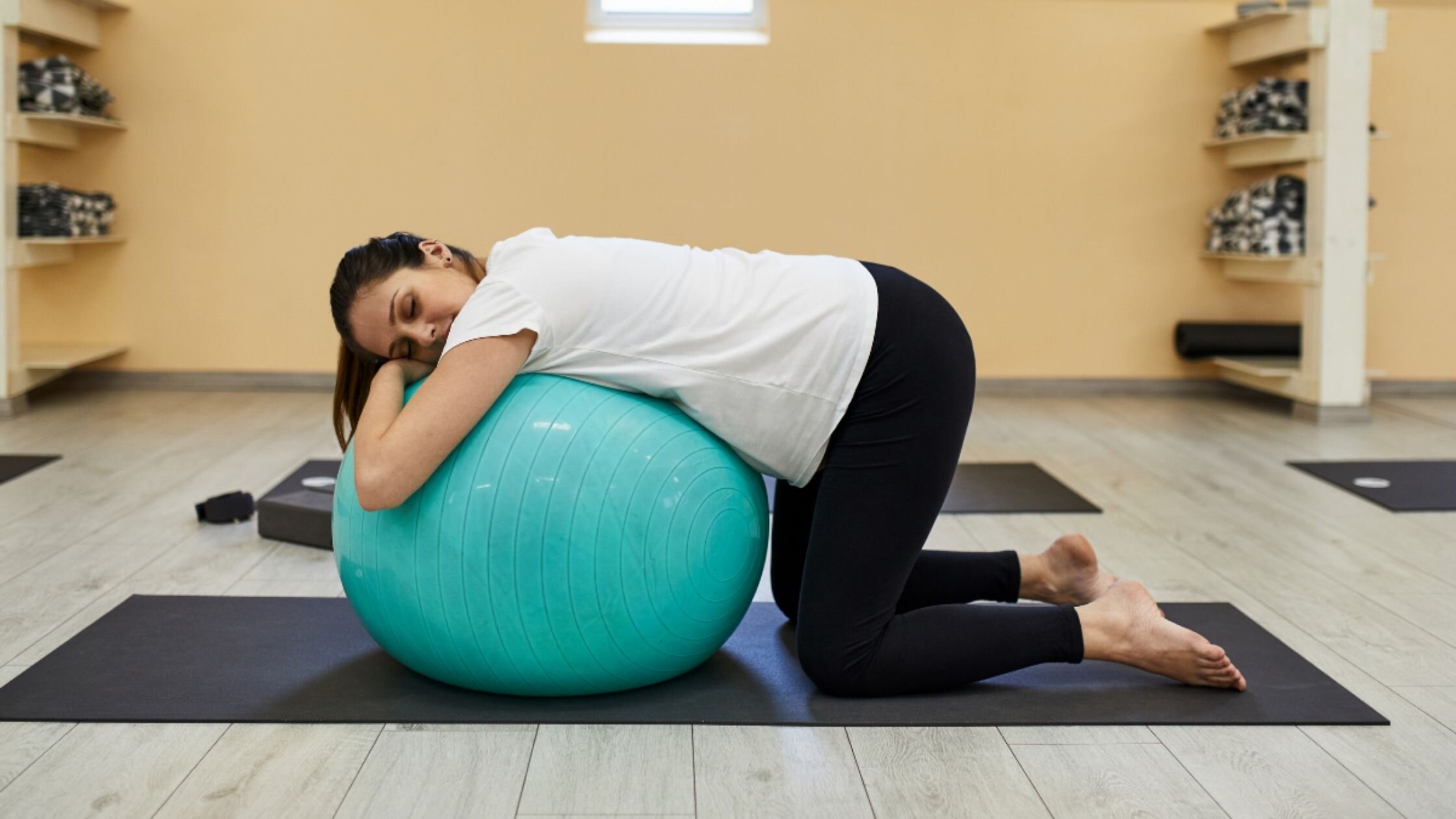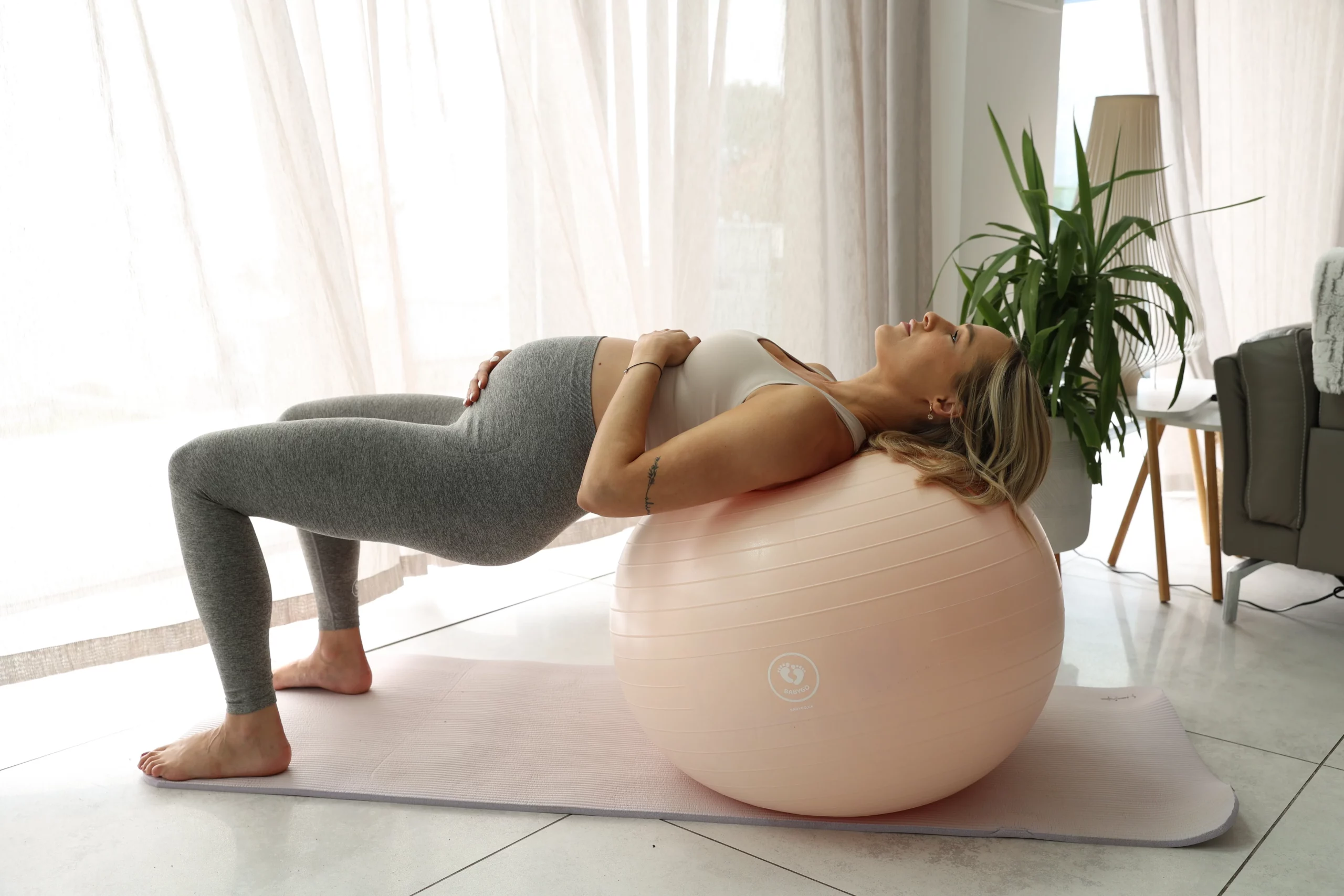Using an exercise ball during pregnancy can offer numerous benefits, including improved posture, reduced back pain, and preparation for labor. However, knowing when to start incorporating an exercise ball into your fitness routine is crucial for safety and effectiveness. In this guide, we’ll share the appropriate timing and guidelines for using an exercise ball during pregnancy, providing insights from health professionals to ensure you and your baby’s well-being while helping you stay active and comfortable throughout your pregnancy journey.’

Contents
When To Begin Using An Exercise Ball During Pregnancy?
As per your body’s unique needs and comfort levels, opt for the exercise or birthing ball at any stage of your pregnancy. Typically, these balls serve as a beneficial tool for reducing discomfort and pain, even in the final weeks of pregnancy.
Around the 32nd week of pregnancy, you might feel increased pressure from the baby on your hips and lower back. That’s when these inflatable spheres come to your rescue. They play a crucial role in relieving hip and back pressure by promoting an anterior positioning for your baby as opposed to a posterior one, known to be a common source of lower back pain.
Exercising with a pregnancy ball aids the process of preparing for labor by strengthening your pelvic floor, stomach, and back. Consequently, you’ll notice a significant increase in the chances of natural childbirth and potential easing of labor woes. However, keep in mind that before beginning exercises with a birthing ball, it’s essential to consult your obstetrician.
Relying on pregnancy ball exercises during this challenging yet beautiful phase can provide you with valuable relief and support. So, take your time and listen to your body. Your journey towards motherhood is unique, and you hold the reins to make it as comfortable and fulfilling as possible.
Benefits of an Exercise Ball During Pregnancy
Regular use of a birthing ball, or exercise ball, during pregnancy yields numerous benefits. Apart from serving as a simple and cost-effective form of exercise, it’s designed to offer support, improving overall physical health and well-being throughout the prenatal stage.

- Body Alignment and Posture Improvement: Usually, there’s an inevitable change in posture during pregnancy due to the growing belly. The use of an exercise ball aids in maintaining proper body alignment, helping in posture correction.
- Pelvic Floor Strength: As you balance on the ball, it engages the core and pelvic floor muscles. Strengthening these muscles can help during labor and enhance postpartum recovery.
- Alleviates Back Pain: Often, pregnancy provokes a significant amount of back pain. Bouncing or rocking on an exercise ball can provide relief and lessen discomfort.
- Active Labor Support: In the throes of labor, an exercise ball allows for movement while providing support. You can lean, sit, or bounce on the ball during contractions to alleviate pain and discomfort.
- Promotes Optimal Fetal Positioning: Exercises on a birthing ball can help align the baby correctly in the womb, potentially aiding in a smoother delivery process.
Exercise Ball Stretches for Labour
Birthing ball exercises offer multiple benefits, including easing labor. Posture enhancement, muscle strengthening, and pressure relief are some noteworthy abilities of this tool. However, you must remember suitable movements and positions to achieve these advantages.

- Deep Squats: Position yourself standing with the ball behind you against a wall. Lower into a squat slowly, letting the ball roll with you. Maintain this position for around 10 seconds and then rise again, repeating the movement 5 times. This strengthens your lower body and prompts pelvis opening, aiding labour.
- Pelvic Tilts: Sit atop the ball with your feet shoulder-width apart. Shift your pelvis forward, then backward. This movement activates your core muscles, offering support during childbirth.
- Figure Eights: Sitting on the ball, make figure-eight patterns with your hips. Maintain an upright posture, this aids in relieving pregnancy discomfort and prepares your body for labour.
How to Use an Exercise Ball Safely?
Here is how to use an exercise ball safely.
1. Choose the Right Size: Ensure the exercise ball is the right size for your height. When sitting on the ball, your hips should be slightly higher than your knees.
2. Use on a Safe Surface: Always use the exercise ball on a flat, non-slip surface to prevent the ball from slipping out from under you.
3. Maintain Good Form: When using the ball, maintain good posture. Keep your back straight and your feet flat on the floor, spaced comfortably apart for stability.
4. Start Slowly: If you are new to using an exercise ball, start with basic exercises to get comfortable with the ball’s movement. Gradually increase the duration and intensity of your workouts as you become more confident.
Is it Safe to Use an Exercise Ball During Pregnancy?
Absolutely, it’s safe to use an exercise ball, often termed birthing ball during pregnancy. The usage, primarily rooted in flushing out discomfort and preparing for labor, can be a beneficial addition to your prenatal routine. However, keep in mind, your body and needs change over the course of pregnancy due to factors like morning sickness, energy levels, and general discomfort.
Exercising with a birthing ball assists in strengthening your core muscles, improving balance, and eases labor pain. Aiming to create an amicable atmosphere for both the mother and the baby, birthing ball exercises focus on movements like pelvic circles, deep squats, and figure eights. In doing so, they ensure your body prepares for labor, opening the pelvis, and activating core muscles.
Safety becomes paramount when you’re pregnant. It becomes essential to consult your healthcare provider before starting any exercise plan, and using a birthing ball is no exception. Instructed usage under expert guidance ensures your safety and aids in reaping the productive benefits of the exercises.
Frequently Asked Questions
Can a birthing ball induce labor?
Yes, a birthing ball can assist in inducing labor. Sitting on a maternity ball in a wide-legged position can increase blood flow, encourage cervical dilation, and open the pelvis, all of which can prepare the body for labor.
When should I start bouncing on my birthing ball?
You can start using your birthing ball for exercises at 32 weeks into your pregnancy. These exercises focus on strengthening your pelvic floor, stomach, and back muscles, preparing you for the stages of labor.
What is the difference between a birthing ball and an exercise ball?
While they are generally the same, a birthing ball is typically made of thicker, anti-burst eco-friendly material. This design is safer as it ensures a slow deflation rather than a sudden pop if punctured, keeping you and the baby safe.
What exercises can I do on the birthing ball while pregnant?
Several exercises can be done on a birthing ball like hip circles, figure eights, side-to-side hip movements, and pelvic tilts. Always maintain good posture and balance during these exercises, with your back straight and legs slightly open.

Hello, I’m Ravindra. Over the years, I’ve immersed myself deeply into the world of fitness and health, transforming both my body and mind. Writing has allowed me to share my journey, insights, and expertise with those just starting out and seasoned fitness enthusiasts alike. Beyond just routines and diets, I believe in inspiring others to adopt a holistic approach to well-being.
